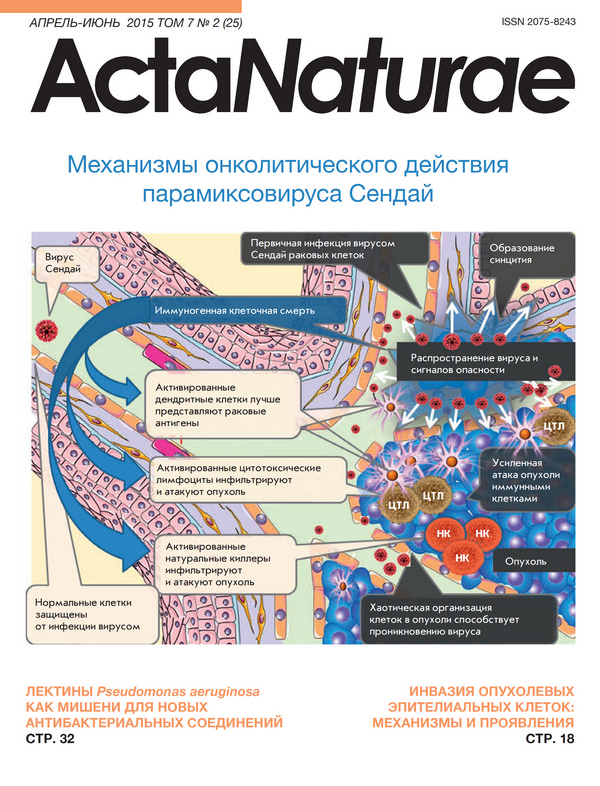The Use of Atomic Force Microscopy for 3D Analysis of Nucleic Acid Hybridization on Microarrays
- Authors: Dubrovin E.V.1, Presnova G.V.1, Rubtsova M.Y.1, Egorov A.M.1,2, Grigorenko V.G1, Yaminsky I.V.1
-
Affiliations:
- Lomonosov Moscow State University
- Russian Medical Academy of Postgraduate Education
- Issue: Vol 7, No 2 (2015)
- Pages: 108-114
- Section: Research Articles
- URL: https://actanaturae.ru/2075-8251/article/view/10511
- DOI: https://doi.org/10.32607/20758251-2015-7-2-108-114
- ID: 10511
Cite item
Abstract
Oligonucleotide microarrays are considered today to be one of the most efficient methods of gene diagnostics. The capability of atomic force microscopy (AFM) to characterize the three-dimensional morphology of single molecules on a surface allows one to use it as an effective tool for the 3D analysis of a microarray for the detection of nucleic acids. The high resolution of AFM offers ways to decrease the detection threshold of target DNA and increase the signal-to-noise ratio. In this work, we suggest an approach to the evaluation of the results of hybridization of gold nanoparticle-labeled nucleic acids on silicon microarrays based on an AFM analysis of the surface both in air and in liquid which takes into account of their three-dimensional structure. We suggest a quantitative measure of the hybridization results which is based on the fraction of the surface area occupied by the nanoparticles.
About the authors
E. V. Dubrovin
Lomonosov Moscow State University
Author for correspondence.
Email: dubrovin@polly.phys.msu.ru
Russian Federation
G. V. Presnova
Lomonosov Moscow State University
Email: dubrovin@polly.phys.msu.ru
Russian Federation
M. Yu. Rubtsova
Lomonosov Moscow State University
Email: dubrovin@polly.phys.msu.ru
Russian Federation
A. M. Egorov
Lomonosov Moscow State University; Russian Medical Academy of Postgraduate Education
Email: dubrovin@polly.phys.msu.ru
Russian Federation
V. G Grigorenko
Lomonosov Moscow State University
Email: dubrovin@polly.phys.msu.ru
Russian Federation
I. V. Yaminsky
Lomonosov Moscow State University
Email: dubrovin@polly.phys.msu.ru
Russian Federation
References
- Schena M., Shalon D., Davis R.W., Brown P.O. // Science. 1995, V.270, P.467-470
- Yoo S.M., Choi J.H., Lee S.Y., Yoo N.C. // J. Microbiol. Biotechnol. 2009, V.19, №7, P.635-646
- Behr M.A., Wilson M.A., Gill W.P., Salamon H., Schoolnik G.K., Rane S., Small P.M. // Science. 1999, V.284, P.1520-1523
- Nuwaysir E.F., Bittner M., Trent J., Barnett J.C., Afshari C.A. // Mol. Carcinog. 1999, V.24, P.153-159
- Iida K., Nishimura I. // Crit. Rev. Oral Biol. Med. 2002, V.13, P.35-50
- Sassolas A., Leca-Bouvier B.D., Blum L.J. // Chem. Rev. 2008, V.108, P.109-139
- Herwig R., Aanstad P., Clark M., Lehrach H. // Nucleic Acids Research 201, V.29, P.e117
- Ryan O., Smyth M.R., Fagain C.O. // Essays Biochem. 1994, V.28, P.129-146
- Lytton-Jean A.K., Han M.S., Mirkin C.A. // Anal. Chem. 2007, V.79, P.6037-6041
- Liao J.C., Mastali M., Gau V., Suchard M.A., Møller A.K., Bruckner D.A., Babbitt J.T., Li Y., Gornbein J., Landaw E.M. // J. Clin. Microbiol. 2006, V.44, P.561-570
- Malic L., Cui B., Veres T., Tabrizian M. // Opt. Lett. 2007, V.32, P.3092-3094
- Hering K.K., Moller R., Fritzsche W., Popp J. // ChemPhysChem. 2008, V.9, P.867-872
- Kim H., Takei H., Yasuda K. // Sens. Actuators. B. 2010, V.144, P.6-10
- Adamcik J., Klinov D.V., Witz G., Sekatskii S.K., Dietler G. // FEBS Lett. 2006, V.580, P.5671-5675
- Dubrovin E.V., Staritsyn S.N., Yakovenko S.A., Yaminsky I.V. // Biomacromolecules. 2007, V.8, P.2258-2261
- Dubrovin E.V., Gerritsen J.W., Zivkovic J., Yaminsky I.V., Speller S. // Colloids Surf. B. 2010, V.76, P.63-69
- Dubrovin E.V., Fedyukina G.N., Kraevsky S.V., Ignatyuk T.E., Yaminsky I.V., Ignatov S.G. // Open Microbiol. J. 2012, V.6, P.22-28
- Dubrovin E.V., Popova A.V., Kraevskiy S.V., Ignatov S.G., Ignatyuk T.E., Yaminsky I.V., Volozhantsev N.V. // PLoS One. 2012, V.7, №10, P.e47348
- Dupres V., Verbelen C., Dufrêne Y.F. // Biomaterials. 2007, V.28, P.2393-2402
- Oh S.J., Cho S.J., Kim C.O., Park J.W. // Langmuir. 2002, V.18, P.1764-1769
- Legay G., Finot E., Meunier-Prest R., Cherkaoui-Malki M., Latruffe N., Dereux A. // Biosens. Bioelectron. 2005, V.21, P.627-636
- Lenigk R., Carles M., Ip N.Y., Sucher N.J. // Langmuir. 2001, V.17, P.2497-2501
- Festag G., Steinbruck A., Wolff A., Csaki A., Moller R., Fritzsche W. // J. Fluoresc. 2005, V.15, P.161-170
- Han W.H., Liao J.M., Chen K.L., Wu S.M., Chiang Y. W., Lo S.T., Chen C.L., Chiang C.M. // Anal. Chem. 2010, V.82, P.2395-2400
- Cook M.A., Chan C.K., Jorgensen P., Ketela T., So D., Tyers M., Ho C.Y. // PLoS One. 2008, V.3, P.e154
- Lavalley V., Chaudouët P., Stambouli V. // Surf. Sci. 2007, V.601, P.5424-5432
- Bush K. // Ann. N.Y. Acad. Sci. 2013, V.1277, P.84-90
- Rubtsova M.Yu., Ulyashova M.M., Bachmann T.T., Schmid R.D., Egorov A.M. // Biochemistry (Mosc). 2010, V.75, P.1628-1649
- Frens G. // Nat. Phys. Sci. 1973, V.241, P.20-22
- Rubtsova M.Yu., Ulyashova M.M., Edelstein M.V., Egorov A.M. // Biosens. Bioelectron. 2010, V.26, №4, P.1252-1260
- Lamture J.B., Beattie K.L., Burke B.E., Eggers M.D., Ehrlich D.J., Fowler R., Hollis M.A., Kosicki B.B., Reich R.K., Smith S.R. // Nucleic Acids Research 1994, V.22, P.2121-2125
Supplementary files







